Step Potentials
The transmission
and reflection coefficients are defined in terms of the probability current, J,
also known as current density
![]()
Consider a
one-dimensional a beam of particles that are plane wave states. The beam is moves in x-direction
and impinges on a barrier as shown in Fig. 1 below
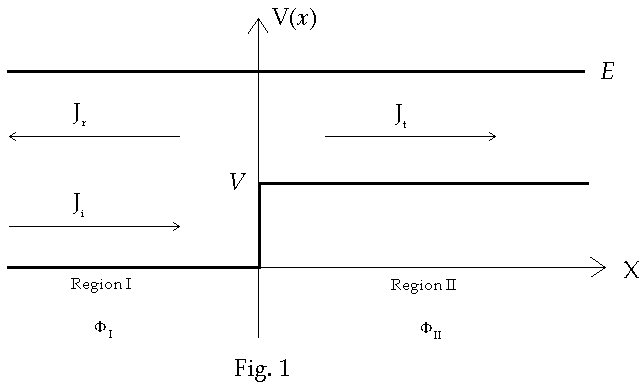
The transmission
coefficient T and reflection coefficient R are defined in terms of the
components of the probability current. Let Ji represent the incoming current, Jt represent the incoming transmitted current,
and Let Jr represent the reflected current
![]()
General Case of Step Potential for
E > V

where, in general,
k1 � k2. The potential is constant for x <
0 and for x > 0 so the wavefunction in each domain is that of a free particle.
Since energy is conserved it follows that Ei = Et = Er
. The wavefunction
for the incoming, transmitted and reflected beams are, respectively
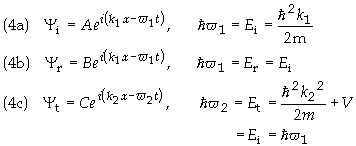
Using Eq. (4a) in
the relation for the current in Eq. (1) gives the x-component of the current
density

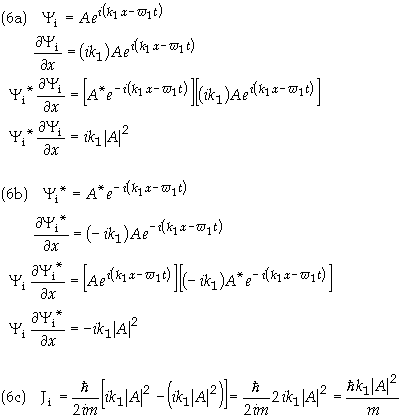
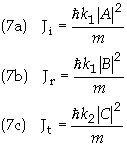
We these values
for the currents the transmission and reflection coefficients become

The
time-independent Schrodinger equation is

For the step
potential shown in Fig. 1 can broken up into two domains. Region I is the domain x
< 0 and Region II is the domain x > 0. The
wavefunction will be partitioned into two parts as well corresponding to each domain. In
Region I the Hamiltonian consists entirely of the kinetic energy term so Eq. (9b) reduces
to

In Region II the Hamiltonian has a kinetic
energy term plus a constant potential

The solution to Eq. (9) and (10) is

Since the time-independent Schrodinger
equation is second order there must be two boundary conditions. First note that we can set
since it is the coefficient of a wave coming from +infinity and since there is no such
wave we can set D = 0. They are determined by the condition that the wavefunction
and its first derivative must be continuous. Applying this criteria at x = 0 means

Taking the derivative of Eq. (12) gives

Applying the boundary condition in Eq. (13a)
gives
![]()
Appling the boundary condition in Eq. (12b)
gives
![]()
Eqs. (15) and (16) can be written simply as

Eq. (17) can be solved for the ratios B1/A1 and C1/A1 to give

The transmission coefficient can now be
written as
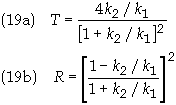
General
Case of Step Potential for E < V
In Region I we
have the same situation as above and therefore the same solution as in Eq. (12a). The
relationship for the reflection coefficient will therefore have the same relation as
above, i.e. R will still be given as in Eq. (8b).
However in Region II the quantity E – V is negative. Therefore

There are two
solutions to Eq. (20), one of which is an exponentially increasing function. This must be
discarded since it leads to a diverging probability density. Therefore the solution is

The derivatives
are

Just as above, applying the boundary
condition defined in Eq. (13a) gives
![]()
Applying the boundary condition defined in
Eq. (13b) gives
![]()
Eqs. (23) and (24) can be written simply as

Eq. (25) can be solved for the ratios B2/A2 and C2/A2 to give

Since the right side of Eq. (26) is of the
form z*/z and therefore | z*/z| = 1. This gives

The transmission coefficient is found by
using the relation R + T = 1. It follows that T = 0. This means that the transmitted
current density is zero. The wavefunction in Region II is multiplied by a decreasing
exponential. The wavefunction therefore does not represent a propagating wave. Such a wave
is called an evanescent wave.
Rectangular Barrier and Tunneling:
Case E > V
Consider now a rectangular barrier for which
E > V as shown in Fig. 2
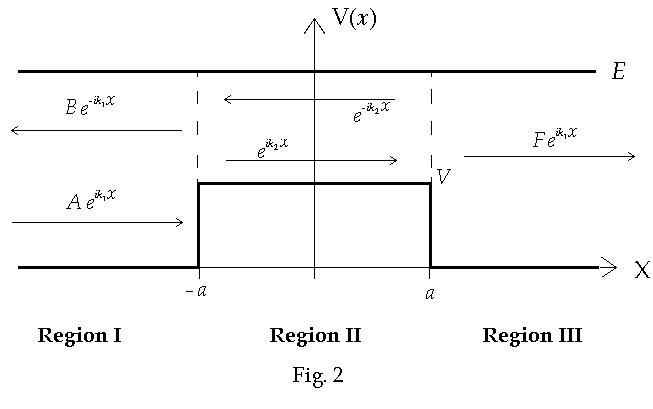
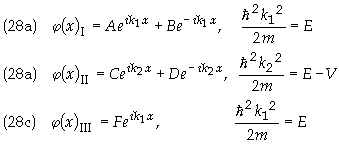

The boundary conditions are
![]()

Applying the boundary conditions in Eq. (30)
gives

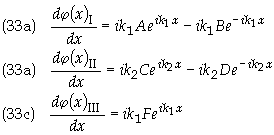
Applying the boundary conditions in Eq. (31)
gives


Dividing Eq. (34) by A gives

Summary of results

After some tedious algebra these equations
can be put into the form

From a calculation similar to Eq. (7) it can
be shown that the transmission and reflection currents are
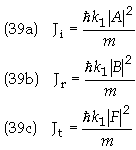
Therefore the transmission and reflection currents are, respectively
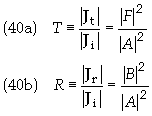
Substituting Eq. (38a) into 1/T gives

To find R use the relation T + R = 1 to give R = 1
– T.